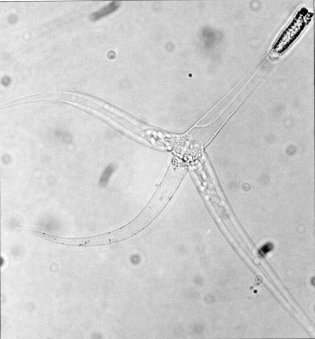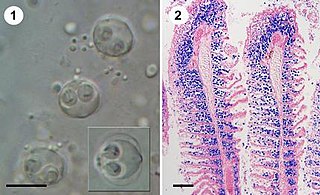
Myxozoa is a subphylum of aquatic cnidarian animals – all obligate parasites. It contains the smallest animals ever known to have lived. Over 2,180 species have been described and some estimates have suggested at least 30,000 undiscovered species. Many have a two-host lifecycle, involving a fish and an annelid worm or a bryozoan. The average size of a myxosporean spore usually ranges from 10 μm to 20 μm, whereas that of a malacosporean spore can be up to 2 mm. Myxozoans can live in both freshwater and marine habitats.

Myxosporea is a class of microscopic parasites, belonging to the Myxozoa clade within Cnidaria. They have a complex life cycle which comprises vegetative forms in two hosts, an aquatic invertebrate and an ectothermic vertebrate, usually a fish. Each host releases a different type of spore. The two forms of spore are so different that until relatively recently they were treated as belonging to different classes within the Myxozoa.

The ring-tailed cardinalfish is a widespread fish species in the family Apogonidae found in the Red Sea and off East Africa to Papua New Guinea, north to Japan, and south to Australia.

Ostorhinchus cyanosoma, commonly known as the yellow-striped cardinalfish, goldenstriped cardinalfish, or the orange-lined cardinalfish, is a species of marine fish in the cardinalfish family of order Perciformes. It is native to the Indo-West Pacific.

Kudoa is a genus of Myxozoa and the only genus recognized within the monotypic family Kudoidae. There are approximately 100 species of Kudoa all of which parasitize on marine and estuarine fish. Kudoa are most commonly known and studied for the negative effects the genus has on commercial fishing and aquaculture industries.
Gadimyxa atlantica is a species of parasitic myxozoan. Together with G. arctica and G. sphaerica, they infect Gadus morhua and Arctogadus glacialis by developing coelozoically in bisporic plasmodia in their urinary systems. These 3 species' spores exhibit two morphological forms: wide and subspherical, being both types bilaterally symmetrical along the suture line. The wide spores have a mean width ranging from 7.5-10μm, respectively, while the subspherical ones range from 5.3-8μm in mean width. The subspherical forms of Gadimyxa are similar to Ortholinea, differing in the development of the spores and in the arrangement of the polar capsules. Polychaetes Spirorbisspecies act as invertebrate hosts of G. atlantica.
Gadimyxa sphaerica is a species of parasitic myxozoan. Together with G. arctica and G. atlantica, they infect Gadus morhua and Arctogadus glacialis by developing coelozoically in bisporic plasmodia in their urinary systems. These 3 species' spores exhibit two morphological forms: wide and subspherical, being both types bilaterally symmetrical along the suture line. The wide spores have a mean width ranging from 7.5-10μm, respectively, while the subspherical ones range from 5.3-8μm in mean width. The subspherical forms of Gadimyxa are similar to Ortholinea, differing in the development of the spores and in the arrangement of the polar capsules.
Gadimyxa arctica is a species of parasitic myxozoan. Together with G. atlantica and G. sphaerica, they infect Gadus morhua and Arctogadus glacialis by developing coelozoically in bisporic plasmodia in their urinary systems. These 3 species' spores exhibit two morphological forms: wide and subspherical, being both types bilaterally symmetrical along the suture line. The wide spores have a mean width ranging from 7.5-10μm, respectively, while the subspherical ones range from 5.3-8μm in mean width. The subspherical forms of Gadimyxa are similar to Ortholinea, differing in the development of the spores and in the arrangement of the polar capsules.
Kudoa paraquadricornis is a myxosporean parasite of marine fishes, first discovered in Australia from 4 carangid species.
Ceratomyxa brayi is a species of myxosporean parasites that infect gall-bladders of serranid fishes from the Great Barrier Reef. It was first found on Cephalopholis boenak.
Ceratomyxa cutmorei is a myxosporean parasite that infects gall-bladders of serranid fishes from the Great Barrier Reef. It was first found on Epinephelus fasciatus.
Ceratomyxa gleesoni is a myxosporean parasite that infects gall-bladders of serranid fishes from the Great Barrier Reef. It was first found on Plectropomus leopardus.
Ceratomyxa hooperi is a myxosporean parasite that infects gall-bladders of serranid fishes from the Great Barrier Reef. It was first found on Epinephelus quoyanus.
Ceratomyxa nolani is a myxosporean parasite that infects gall-bladders of serranid fishes from the Great Barrier Reef. It was first found on Epinephelus quoyanus.
Ceratomyxa whippsi is a myxosporean parasite that infects gall-bladders of serranid fishes from the Great Barrier Reef. It was first found on Cephalopholis boenak.

František Moravec is a Czech parasitologist who specialises on the Nematodes, especially the nematodes parasites of fishes. His research is mainly in the field of taxonomy of the Nematoda.

Enteromyxum leei is a species of myxozoan, histozoic parasite that infects the intestinal tract and sometimes associated organs, like gall bladder and liver, of several teleostean fish species. Myxozoans are microscopic metazoans, with an obligate parasitic life-style. The parasite stages of this species live in the paracelullar space between fish enterocytes. It is the causative agent of enteromyxosis, or emaciative disease, also known as "razor blade syndrome" in sparid fish. E. leei has a wide host and geographical range within marine fish, and even freshwater fish have been infected experimentally. E. leei initially emerged in the Mediterranean in the late 1980s and it is believed to have been unintentionally introduced into the Red Sea. Its pathogenicity and economic impact depend on the host species. In the gilt-head seabream, it is manifested as a chronic disease that provokes anorexia, delayed growth with weight loss, cachexia, reduced marketability and increased mortality. In other species, it has no clinical signs. In sharpsnout seabream, infection results in very high mortality rates, which have pushed fish farmers to abandon the culture of this fish species.

Sphaerospora molnari is a microscopic endoparasite of carp in pond cultures and natural freshwater habitats in Central and Eastern Europe. In natural infections, S. molnari invades the epithelia of gills and surrounding skin regions. It then forms spores in between epithelial cells, causing sphaerosporosis, a pathological condition of the skin and gill tissues. Affected tissues show marked dystrophic changes and necrosis, causing secondary bacterial infections and resulting in osmoregulatory and respiratory failure. Mortalities can reach 100% but little is known about the overall distribution of the parasite species in European carp ponds or its economic impact on carp aquaculture.
Carlos José Correia de Azevedo is a Portuguese biologist specialising in microparasites of aquatic organisms, particularly Apicomplexa, Haplosporidia, Microsporidia, and Myxozoa.
Ceratomyxa auratae is a species of myxozoan parasite that infects the gall bladder of the gilthead seabream, Sparus aurata. It was discovered in an aquaculture facility in southern Portugal.






